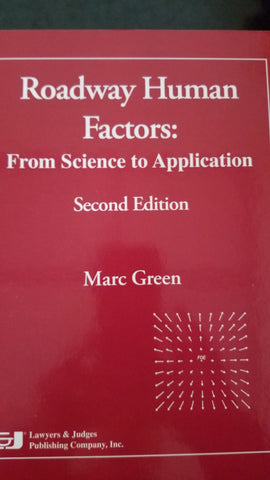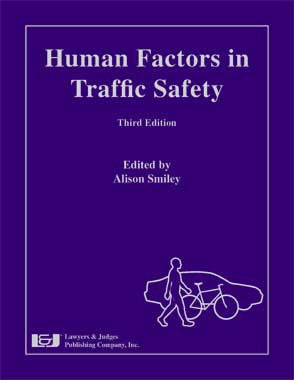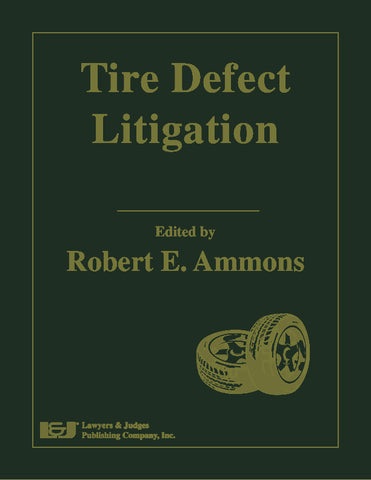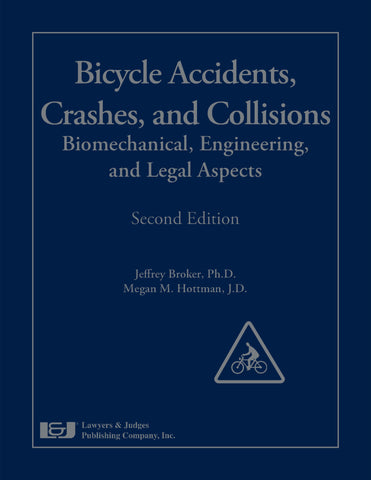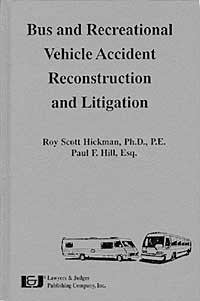
Bus and Recreational Vehicle Accident Reconstruction and Litigation
- Author: Roy Scott Hickman, Paul F. Hill
- ISBN 10: 0-913875-76-7
- ISBN 13: 978-0-913875-76-6
- Copyright Date Ed: February 24, 2000
- Pages: 528 pages
- Binding Information: Casebound
-
Size: 6 ✕ 9 Inches (US)
Build and reconstruct an accident involving a school bus, motor coach or recreational vehicle.
Accidents make up the leading cause of claims against transit agencies. Similarly, bus operator negligence is often the cause of these accidents and preventable. You will learn about the hallmarks of an effective risk management program. Which passengers and types of buses and recreational vehicles are most at risk for being involved in a serious accident? How can a transit company accurately trend and forecast future losses? All this information and more is provided in the many tables and examples located throughout this book. Because buses and trucks are built in a similar fashion, bus-automobile accidents are often dramatically serious for automobile occupants. Do these occupants have a claim? When litigating a claim against a transit company, there are many issues to confront. Was the driver properly trained? How was the driver trained? Did the bus-company perform drug and alcohol tests, driver records checks, background checks, or routine safety evaluations on the driver? How was maintenance and repair of the vehicle handled? Were the occupants' behaviors or medical conditions a factor in the accident? Can perception-reaction time be accurately determined? Do you have enough evidence for a claim?
With this book, you will know what type of information has yet to be explored--such as the National Safety Councils records on all types of bus accidents called FARS. Bus and Recreational Vehicle Accident Reconstruction and Litigation will help you to recognize, develop, and ultimately to prove or defend liability. It blends the talents of the legal, engineering, mechanical, and investigation disciplines.
This book is also available as an eBook. Click here to purchase and download:
TOPICS COVERED
- Introduction to bus accidents
- History and statistics of bus accidents
- Common features of buses
- Inter-city buses
- Transit buses
- School buses
- Other buses and recreational vehicles
- Accident reconstruction
- Driver issues
- Comments on the attorney-expert relationship selection
- Digital demonstrative evidence
- Governmental immunity and damage caps
- Negligence for location of school bus stop
- Passenger boarding city or inter-city bus
- Passenger alighting from city or inter-city bus
- Public buses: sudden stops, swerves, bumps and other causes of injuries while riding
- School buses: injury while boarding, riding or alighting
- Public buses: liability for injury from assaults and unruly behavior
- Miscellaneous bus driver's duties
- Bus driver issues: respondeat superior, independent contractor, negligent hiring including medical conditions
- Product liability and negligent repair or maintenance Insurance considerations
- evaluating possible claims
Table of Contents
Part I: Accident Reconstruction
Chapter 1: Introduction 1
1.1 Bus Types
1.2 Types of Buses--Some General Comments
1.3 Operators
1.4 Accidents and Incidents
1.5 How to Use This Book
Chapter 2: History and Statistics>
2.1 Buses--Some General Comments
2.2 Bus Accident Studies
A. Jovanis study
B. The Michigan study
C. The Abacus Technology Corporation study
D. The Federal Transit Administration
E. The Risk and Insurance Management Society, Inc. study
F. The Michael M. Kaddatz stud
2.3 School Buses
2.4 Legal Issues
2.5 Insurance Protection
2.6 Conclusion
Chapter 3: Common Features of Buses
3.1 Introduction
3.2 General Characteristics of Bus Accidents
3.3 Passengers
3.4 Driver's Station
3.5 Braking Systems
A. Foundation brakes
B. Spring brakes
3.6 Brake Operation Systems
A. Hydraulic brakes
B. Air brakes
3.7 Air Brake Operation
A. Service brake system
B. Parking brake system
3.8 Emergency Operation
3.9 Air System Accessories
3.10 Antilock Braking and Brake Retarders
3.11 Brake Linings
3.12 Tires
3.13 Time Lag in Air Brake Systems
3.14 SAE Recommended Practices
3.15 SAE Standards and Procedures
3.16 General Safety Issues
3.17 Handicapped Access Issues
3.18 Conclusion
Chapter 4: Inter-City Buses
4.1 Characteristics
4.2 Prevost Car Inc. of Saint Claire, Quebec, Canada
4.3 Rollover Accidents
4.4 Seat Belts
4.5 Enclosed Overhead Luggage Racks
4.6 Federal Motor Vehicle Standards
4.7 Other Federal Activity
4.8 Some Specific Accidents Involving Coaches
A. Mexico
B. Bus vault accidents
C. Atlantic City, New Jersey
D. New Orleans, Louisiana
E. Pittsburgh, Pennsylvania
F. Rancho Cucamonga, California
G. St. Joseph De La Rive, Quebec
H. Coach-truck collision
I. Rollover accident
J. Loss of control and collision with a bridge rail
K. Tour bus rollover
L. Bus strikes the rear of a truck trailer
4.9 Conclusion
Chapter 5: Transit Buses
5.1 Introduction
5.2 Handicapped Access
5.3 Entry Height
5.4 Cost
5.5 Types of Accidents and Incidents
5.6 Causes of Accidents and Incidents
5.7 Selection and Hiring Drivers
5.8 Defensive Driving Training
5.9 Simulators Used in Driver Training
5.10 Driver Incentive Programs
5.11 Customer Safety Programs
5.12 Driver Vision
5.13 Doors and Door Controls
5.14 Handrails, Stanchions, and Edge Markings
5.15 Seat Belts
5.16 Injury
5.17 Articulated Buses
5.18 Brake Lights and Warning Signals
5.19 Bus Stops
A. Near side stops
B. Far side stops
C. Mid-block stops
D. Bus turnouts and pullouts
E. Bus stop pads
F. Shelters
5.20 Safety Management Programs
A. Accident and incident procedures
B. Reduction of questionable claims
5.21 Review of Some Recalls and Safety Related Actions
A. Allied-Signal Inc.
B. Chance Coach Inc., of Wichita, Kansas
C. Crane Carrier Co., of Tulsa, Oklahoma
D. Flexible Metro Buses
E. General Motors Corp.
F. Goshen Coach 127
G. National Seating Co.
H. Navistar International Transportation Corp.
I. Neoplan Buses Usa Corp., of Lamar, Colorado
J. Orion Transit Buses (Transit Manufacturing Inc., of Oriskany New Jersey, formerly Bus Industries of America Inc.)
K. Oshkosh Truck Corp.
L. Stewart & Stevenson Buses
N. Thomas Built Buses Inc., of High Point, North Carolina
O. Transportaion Manufacturing Co. of Roswell, New Mexico
5.22 Some Transit Bus Accidents
A. Normandy, Missouri
B. Cosmopolis, Washington
C. New York City, New York
D. Nashville, Tennessee
E. Santa Clara County, California
F. Palos Verdes, California
G. Hollywood, California
H. Los Angeles, California
I. Seattle, Washington
J. Sherman Oaks, California
5.23 Conclusion
Chapter 6: School Buses
6.1 Introduction
6.2 Compartmentalization
6.3 Clothing Snags
6.4 Loading Zones
6.5 Seat Belts and Passive Protection
6.6 Recalls and Investigations
A. Amtran school buses
B. Blue Bird
C. Chance Coach Inc., of Wichita, Kansas
D. Carpenter school bus chassis
E. Coach And Equipment Manufacturing Corp.
F. Collins school buses
G. Crane Carrier Co.
H. Crown Coach
I. Ford Motor Company
J. General Motors Corp.
K. Navistar International Transportation Corp.
L. Oshkosh Truck Corp.
M. Thomas Built Buses Inc.
N. Van-Con school buses
O. Wayne Wheeled Vehicles
6.7 Accidents
6.8 Train And School Bus Accidents
A. Buffalo, Montana
B. Sinton, Texas
C. Port Allen, Louisiana
D. Morehouse Parish, Louisiana
E. Fox River Grove, Illinois
F. Apopka, Florida
G. Chicago, Illinois
H. Lafayette, Oregon
I. Somerdale, New Jersey
J. Greeley, Colorado
K. Pekin, Illinois
L. Grant City Station, N.Y.C., New York
M. Mountain Lake Park, Maryland
N. North Harvey, Illinois
O. Spring City, Tennessee
P. Riverton, Utah
6.9 NTSB Crash Investigations
A. Beaumont, Texas, December 23, 1983
B. Johnsondale, California, March 5, 1985
C. Ackerly, Texas, July 20, 1985; Eureka Springs, Arkansas, September 13, 1985 and Bramwell. West Virginia, October 14, 1985
D. Snyder, Oklahoma
E. St. Louis County, Missouri, November 11, 19859
F. Miami, Florida, September 28,1983
G. Birmingham, Alabama, April 12, 1984
H. Tuba City, Arizona
I. Jefferson, North Carolina, March 13, 1985
J. Los Angeles, California, June 23,1999
K. Los Angeles, California, December 1995
Chapter 7: Other Buses and Recreational Vehicles
7.1 Airport Shuttle Buses
A. Entry steps
B. Seat belts
C. Handicapped riders
7.2 Recreational Vehicles
A. Types and components
B. Recalls of RVs and RV parts
Chapter 8: Accident Reconstruction
8.1 Introduction
8.2 Skid Mark Analysis, Perception Reaction Times and Braking Processes
A. Perception time
B. Reaction time
8.3 Some Preliminaries
8.4 Friction
8.5 Hydroplaning
8.6 Skids
8.7 Conservation of Linear Momentum
8.8 Simple Examples
8.9 Delta-v
8.10 Crush of Vehicles
8.11 Coefficient of Restitution
8.12 Brush-by Accidents
8.13 Summary
Chapter 9: Driver Issues
9.1 Introduction 9.2 Driver Selection and Training
A. Selection and hiring drivers
B. Defensive driving training
C. Simulators used in driver training
D. Driver incentive programs
9.3 Drugs and Alcohol
9.4 Safety Inspections
9.5 Driver Altercations
9.6 Driver Disability
9.7 Driver Comfort and Well Being
9.8 Literature
Chapter 10: Comments on the Attorney-Expert Relationship: Selecting and Working with the Expert
10.1 Introduction
10.2 Tests for Expert Testimony
10.3 Fees
10.4 Referral Services
10.5 Pro Bono Work
10.6 Bias
10.7 Opposing Experts
10.8 Depositions of Opposing Experts
10.9 Qualifying an Expert
10.10 Arguments Concerning Expert Witnesses' Opinions
10.11 Cross-examining the Opposing Expert Witness
10.12 Comments for Experts
10.13 Ethics
10.14 Fees and Contracts
10.15 Meetings with Experts
10.16 Files
10.17 Depositions
10.18 Video Depositions
10.19 Trial
10.20 Summary
Chapter 11: Digital Demonstrative Evidence
11.1 Introduction
11.2 Special Effects
11.3 Medical
11.4 Product Litigation
11.5 Digital Video and Nonlinear Editing
11.6 Computer Animation
11.7 Accuracy
11.8 Two-Dimensional Drawings
11.9 Three-Dimensional Animation of Actual Objects
11.10 Computer Animation
11.11 Animation Costs
11.12 Computer Simulation
11.13 Presentation in the Courtroom and Deposition
A. Analog videotape
B. Laser disc
C. CD-ROM
D. Digital video tape
11.14 Display Equipment in the Courtroom
11.15 The Attorney's Role in Preparing Digital Demonstrative Testimony or Data
11.16 The Attorney's Role in Preparing for Opposing Digital Demonstrative Testimony or Data
11.17 Access to the Computer Program
11.18 The Opposition's Animation
11.19 Summary
Part II: Litigation
Chapter 12: Governmental Immunity and Damage Caps
Chapter 13: Negligence for Location of School Bus Stop
Chapter 14: Passenger Boarding City or Inter-City Bus
Chapter 15:Passenger Alighting from City or Inter-City Bus
Chapter 16: Public Buses: Sudden Stops, Swerves, Bumps and Other Causes of Injuries while Riding
Chapter 17: School Buses: Injury while Boarding, Riding, or Alighting
Chapter 18: Public Bus: Liability for Assault by Fellow Passenger, Bus Driver, or External Attacks
Chapter 19: School Buses: Liability for Injury from Assaults and Unruly Behavior
Chapter 20: Miscellaneous Bus Driver's Duties
Chapter 21: Bus Driver Issues: Respondent Superior, Independent Contractor, Negligent Hiring Including Medical Conditions
Chapter 22: Product Liability and Negligent Repair or Maintenance
Chapter 23: Insurance Considerations

